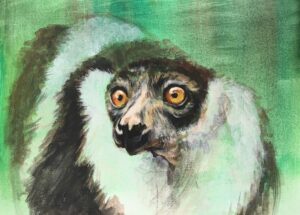I absolutely love lemurs, because they look so much like monkeys as well as dogs. They jump, climb and look at you with their enormous big round eyes. This lovely lemur painting was based on a photo we took from Wildwood Trust, which is a conservation centre for British wildlife.
Here, clearly, lemur comes beyond the British soil. Lemurs are prosimians, a type of primate. Other primates include monkeys, apes and humans. Lemurs are endemic to Madagascar, where they evolved in isolation.
Here are some facts about Lemur:
- This lemur’s name is Black and white ruffed lemur(Varecia variegata). They are endemic to the island of Madagascar, like all lemures species, they can only be found there.
- They make nests for their young, like birds. Female lemurs often give birth to twins or triplets after a 90-120 gestation period, then the newborn will be placed in the nest on the tree 10 to 20 metres above the ground. The young stay in the nest while the female forages. When a female needs to travel with her young, she carries the in her mouth, like dogs, rather than her belly.
- The B&W lemurs are known as the world’s largest pollinators, due to their mutualistic relationship with the traveller’s tree. As they are primarily frugivorous, the tree benefits from the pollination that occurs when the pollen sticks to the lemurs’ faces and gets transported to the next tree.
- Lemurs are among the most threatened groups of mammals. The International Union for the Conservation of Nature (IUCN) estimates that over 95% of lemurs face extinction in the next 20 years. The primary threats facing black-and-white ruffed lemurs include logging, slash-and-burn agriculture, mining, development, and hunting. Their large size and diurnal activities make them easier targets for hunters and this has put great pressure on their population. Protecting and preserving lemur habitats in Madagascar is essential to their survival.
References:
https://nationalzoo.si.edu/animals/black-and-white-ruffed-lemur





